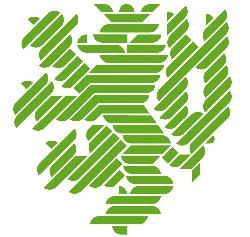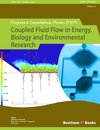
|
Bergische Universität Wuppertal
|

|
|

|
Bergische Universität Wuppertal
|

|
|

[click to enlarge] |
Coupled Fluid Flow in Energy, Biology and Environmental ResearchMatthias Ehrhardt (ed.)E-Book Series Progress in Computational Physics (PiCP), Volume 2Bentham Science Publishers, May 2012.Book Webpage at Publisher |
|

[click to enlarge] |
 |
Left figure:
Microfluidic biochips represent an important example of chip-based
miniature laboratories that can be controlled
electronically (``labs-on-a-chip'' concept). Right figure: Illustration of the computed propagation of the surface acoustic waves (SAWs) in a microchannel where the SAWs penetrate the channel at its lower left end. The SAWs propagate from the left to the right and undergo a significant damping. Pictures are courtesy of Ronald H.W. Hoppe, University of Houston, USA and University of Augsburg, Germany. |
 |
Subject: The planned scientific topics in the fields of modeling, numerical methods and applications will include
This second volume contains both, the mathematical analysis of the coupling between fluid flow and porous media flow and state-of-the art numerical techniques, like tailor-made finite element and finite volume methods. Finally, a couple of chapters are devoted to concrete applications in the field of energy, biology and environmental research.
Purpose: The purpose of this book is to give an overview on the current state-of-the-art research on
The book is designed to be consisting of a collection of contributed chapters. Outstanding experts working successfully in this challenging research area will be invited to contribute each a chapter of roughly 30-40 pages to this volume.
Academic Level: The principal audience is Ph.D. students and lecturer of computational physics and numerical mathematics and also engineers working in this application fields.
by Kambiz Vafai, University of California, Riverside, USA.
Coupled Fluid Flow Problems, (2 pages)
by Matthias Ehrhardt, Lehrstuhl für Angewandte Mathematik und Numerische Mathematik, Fachbereich Mathematik und Naturwissenschaften, Bergische Universität Wuppertal, Wuppertal, Germany.
An Introduction to Fluid-Porous Interface Coupling (9 pages)
by Matthias Ehrhardt, Lehrstuhl für Angewandte Mathematik und Numerische Mathematik, Fachbereich Mathematik und Naturwissenschaften, Bergische Universität Wuppertal, Wuppertal, Germany.
Abstract: Numerical simulation of coupled flows in plain and porous media is essential for many industrial and environmental problems. In this introductory chapter we shortly review coupling conditions between the pure liquid flow and the flow in a porous medium. Hereby, we will discuss the two well studied cases of normal and parallel flow over a porous layer ans focus on the later one Furthermore, we regard mass transport from the fluid region to the porous layer.
As an application, we present two examples modelling Proton exchange membrane (PEM) fuel cells and an electrochemical channel flow cell.
After discussing three different mathematical models the chapter will focus on the description of the coupling of the free flow in the channel region with the filtration velocity in the porous diffusion layer as well as interface conditions between them.
The difficulty in finding effective coupling conditions at the interface between the channel flow and the porous layer lies in the fact that often the orders of the corresponding differential operators are different, e.g. when using (Navier-) Stokes and Darcy's equation. Alternatively, using the Brinkman model for the porous media this difficuly does not occur.
We will review different interface conditions, including the well-known Beavers-Joseph-Saffman boundary condition and its recent improvement by Le Bars and Worster. Finally, three different mathematical models for fluid-porous interfaces in a simple channel geometry are discussed and explicit Poiseuille-like solutions are derived that can lead to semi-analytic numerical methods.Modelling transfers at a fluid-porous interface: A multi-scale approach (.. pages)
by Marion Chandesris, CEA, French Atomic Energy Commission (Commissariat à l'énergie atomique), France.
and Didier Jamet, CEA, French Atomic Energy Commission (Commissariat à l'énergie atomique), France.
Abstract: Free flows above porous medium are present in many industrial or environmental applications. To study such problems, a common approach consists in coupling a free fluid model with a porous model, the transfers that occur at the fluid-porous interface being modeled through appropriate boundary conditions. However, the determination of these boundary conditions is not trivial and remains an important issue for the study of practical applications.
Here, we present a multi-scale method that allows to determine the form of the boundary conditions and to determine the value of the jump parameters that appear in the expression of these boundary conditions. This theoretical approach allows to analyze the physical nature of the jump coefficients and to determine whether these jump coefficients are intrinsic parameters or not.
This method is illustrated through its application on different important transport phenomena at a fluid-porous interface such as heat conduction or laminar flow over a porous medium.
Numerical methods for subsurface flows and coupling with surface runoff (10 pages)
by Pierre Sochala, BRGM (French Geological Survey), 3 avenue Claude-Guillemin - BP 36009 - 45060 Orléans Cedex 2, France.
and Alexandre Ern, Université Paris-Est, CERMICS, Ecole des Ponts, Champs sur Marne, 77455 Marne la Vallée Cedex 2, France.
Abstract: Accurate and robust numerical schemes are proposed to simulate subsurface flows and their coupling with surface runoff. Subsurface flows are modelled by the (unsteady) Richards' equation discretized by a BDF in time and a discontinuous Galerkin method with symmetric interior penalty in space. Runoff flow is taken into account through coupling conditions enforcing water flux equality and pressure continuity at the interface. Overland flows are modelled by the kinematic wave approximation of the shallow water equations, which is discretized by a Godunov method. Both schemes, that for the subsurface flow and that for the overland flow, are mass conservative and can be coupled within a multiple time step procedure. To ensure total water mass conservation for the whole system, interface fluxes must be carefully designed. We specify the form of these fluxes for BDF1 and BDF2. Accuracy and robustness of our schemes are assessed on several test cases (e.g. drainage, exfiltration and hortonian runoff). Finally, we apply the methology to investigate the hydrological behavior of a small-scale drained watershed.
Spectral discretization of the Stokes problem with mixed boundary conditions (20 pages)
by K. Amoura, Université Badji-Mokhtar, Faculté des Sciences, Département de Mathématiques, B.P. 12, 23000 Annaba, Algeria.
and Christine Bernardi, Laboratoire Jacques-Louis Lions, Paris, France.
and N. Chorfi, Department of Mathematics, College of Science, King Saud University, Riyadh 11451, Saudi Arabia.
and S. Saadi, Université Badji-Mokhtar, Faculté des Sciences, Département de Mathématiques, B.P. 12, 23000 Annaba, Algeria.
Abstract: The variational formulation of the Stokes problem with three independent unknowns, the vorticity, the velocity and the pressure, was born to handle non standard boundary conditions which involve the normal component of the velocity and the tangential components of the vorticity. We propose an extension of this formulation to the case of mixed boundary conditions in a three-dimensional domain. Next we consider a spectral discretization of this problem. A detailed numerical analysis leads to error estimates for the three unknowns and numerical experiments confirm the interest of the discretization.
Decoupled Algorithms for the Coupled Surface/Subsurface Flow Interaction Problems (25 pages)
by Mingchao Cai, Institute of Applied Mathematics, TU Dortmund, Germany.
Abstract: Research works on the coupling of incompressible surface flow with subsurface porous media flow arouse increasing interest recently. The coupled problems are typical multi-domain problems with multi-physics. Correspondingly, the heterogeneous partial differential equations for modeling these problems are coupled together at the interface between different domains. In the present work, we mainly study numerical methods for the coupled (Navier-) Stokes/Darcy models, which are typical models for stationary surface/subsurface flow interactions. We propose several decoupled algorithms so that numerical computations can be realized in parallel. Specifically, we investigate decoupled preconditioning techniques and two grid algorithms. Numerical examples and mathematical analysis are given to show that these algorithms are effective and efficient.
Integrated Multi-Model Description of the Human Lungs (17 pages)
by Céline Grandmont, INRIA, REO project-team, Le Chesnay Cedex, France.
and Bertrand Maury, Laboratoire de Mathématiques, Université Paris-Sud, France.
Abstract: The respiratory system realizes the transfer of oxygen from the outside air to the alveolar membrane, through which it diffuses onto the blood. As pure diffusion is far from being sufficient to realize that transfer, most of it is of advective type, and this advection is triggered by inflation-deflation cycles of the paremchyma. The mechanical part of the lungs can then be seen as a tree-like domain (conducting airways) embedded in an elastic medium. The flow in the upper part is inertial (incompressible Navier-Stokes equations), whereas inertia can be neglected for deeper branches (Stokes equations), which allows to use Poiseuille's law for each branch, and consequently Darcy like equations on the corresponding subtrees.
We aim at addressing the delicate issues in terms of theory, numerics, and modelling, raised by the coupling of those models (Navier-Stokes, Darcy equations on a network, elasticity equations).
Multiscale and Multiphysics Aspects in Modeling and Simulation of Surface Acoustic Wave Driven Microfluidic Biochips (27 pages)
by Harbir Antil, Department of Computational and Applied Mathematics, Rice University, Houston, TX, USA.
and Ronald H.W. Hoppe, Department of Mathematics, University of Houston, Houston, Texas, USA and Faculty of Mathematics and Natural Sciences, University of Augsburg, Germany.
and Christopher Linsenmann, Institute of Mathematics, University of Augsburg, Augsburg, Germany.
and Achim Wixforth Institute of Physics, University of Augsburg, Augsburg, Germany.Abstract: Microfluidics is the science dealing with the behavior, precise control, and manipulation of fluids in the sub-millimeter regime. Microfluidic biochips are devices that are designed for high throughput screening and hybridization in genomics, protein profiling in proteomics, and cell analysis in cytometry. They are used in clinical diagnostics, pharmaceutics and forensics. The biochips consist of a lithographically produced network of channels and reservoirs on top of a glass or plastic plate. The idea is to transport the injected DNA or protein probes in the amount of nanoliters along the network to a reservoir where the chemical analysis is performed. Conventional biochips use external pumps to generate the fluid flow within the network. A more precise control of the fluid flow can be achieved by piezoelectrically agitated surface acoustic waves (SAW) generated by interdigital transducers on top of the chip, traveling across the surface and entering the fluid filled channels. The fluid and SAW interaction can be described by a mathematical model which consists of a coupling of the piezoelectric equations and the compressible Navier-Stokes equations featuring processes that occur on vastly different time scales. In this contribution, we follow a homogenization approach in order to cope with the multiscale behavior of the coupled system that enables a separate treatment of the fast and slowly varying processes. The resulting model equations are the basis for the numerical simulation which is taken care of by implicit time stepping and finite element discretizations in space. Finally, the need for a better efficiency and cost effectiveness of the SAW driven biochips in the sense of a significant speed-up and more favorable reliability of the hybridization process requires an improved design which will also be addressed in this contribution. In particular, the challenge to deal with the resulting large scale optimal control and optimization problems can be met by the application of projection based model reduction techniques.
|